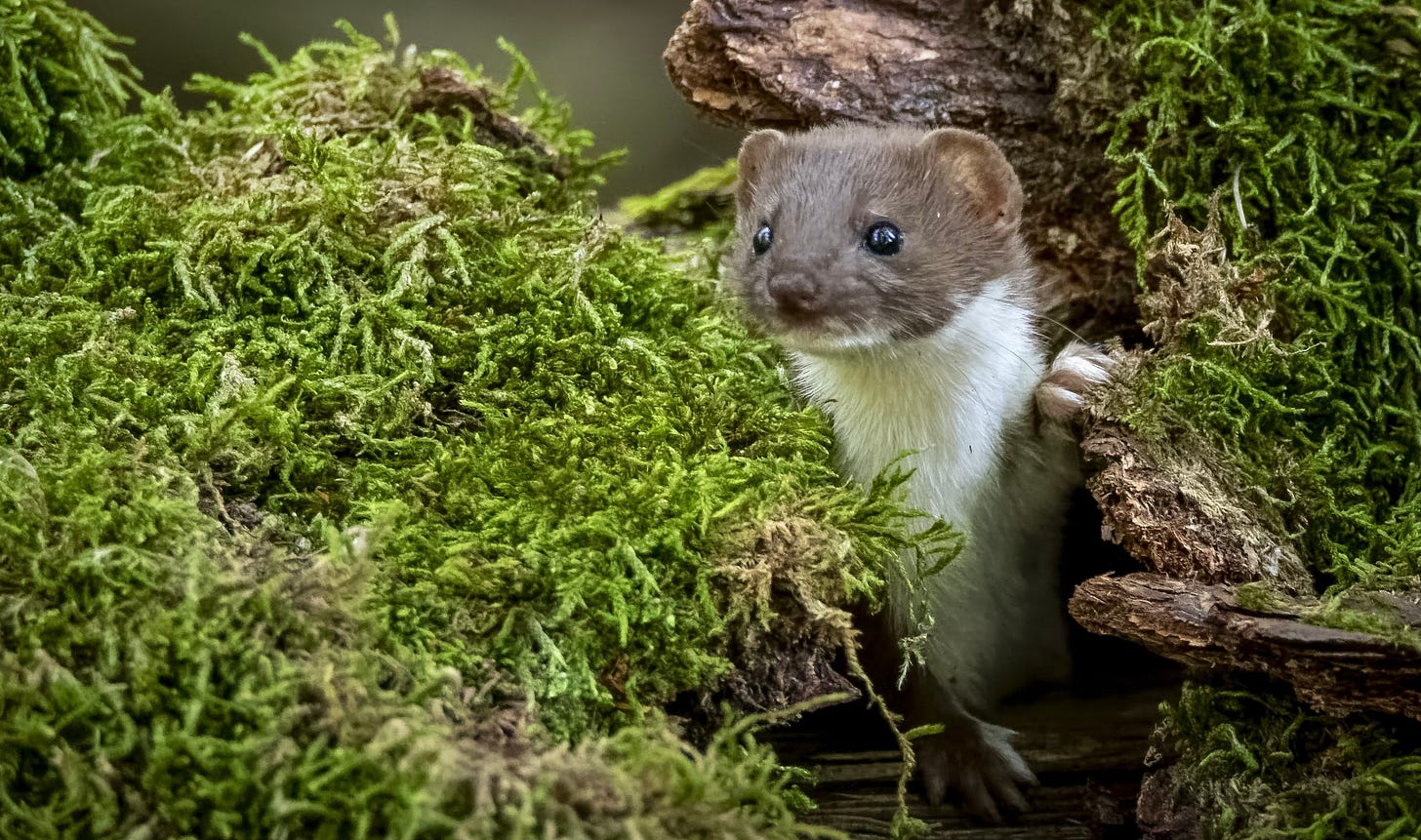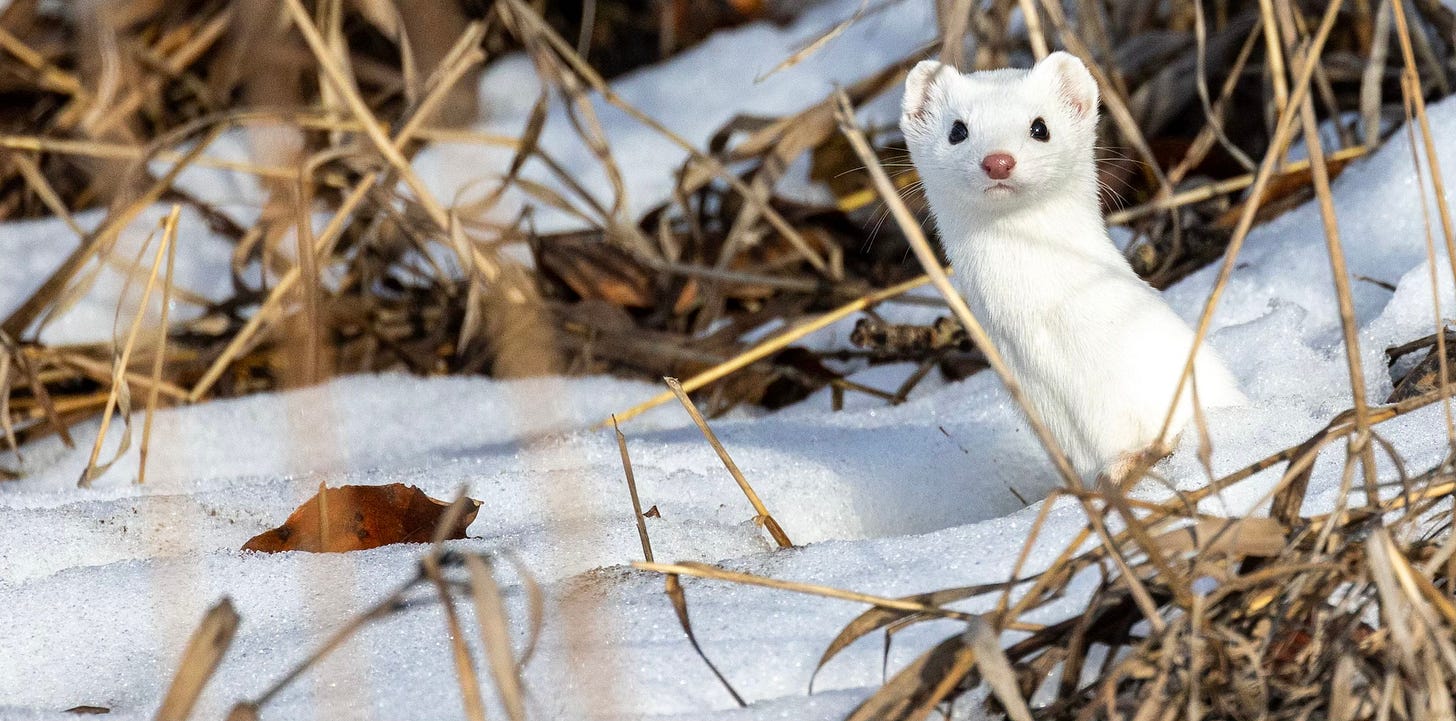Red meat to save the weasels
Plus Mexico's iconic salamander needs some help to stay in the wild
By Dan Fletcher
Here is today’s audio edition:
Researchers just completed the first large-scale study on how to effectively monitor North American weasels — those tiny, lightning-fast predators that are exceedingly difficult to spot, let alone count. Their findings could transform how we track declining weasel species and ensure their survival.
But before we dive in… some great news on our own conservation efforts. When I wrote you Friday, our FUZZ Funds for this month's donation to one of three very worthy groups stood at just under $250. Thanks to your incredible support through FUZZ Mug purchases and new annual subscriptions, we're now at $406 for March's conservation donation! This will be our largest yet but let’s not stop here.
There's still one day left to join and vote on where these funds go. Upgrade your subscription or grab a FUZZ Mug (minimum $25 contribution) and 100% of your support will directly fund this month's conservation winner, which we'll announce Wednesday. (I've even added a 14oz mug option since several of you mentioned the 11oz wasn't sufficient for your morning brew.)
And now onto the weasels…
Weasels are in trouble. Both long-tailed weasels (which look like stretched-out ferrets) and short-tailed weasels (also called ermines) appear to be declining across much of North America, but we lack good monitoring data to confirm this. Traditional camera trap setups rarely catch weasels — they're just too small and too fast for standard equipment.
So what did scientists discover works best? Meat. Red meat.
Camera traps baited with red meat were 3.5 times more likely to detect weasels than those using only scent lures. For short-tailed weasels, red meat was twice as effective as chicken or cat food. And adding salmon oil as a scent enhancer made things even better — it reduced detection time and kept attracting weasels even if the meat bait was stolen by other wildlife (which happened a lot).
This isn't just academic trivia — it's a conservation breakthrough. Having an effective, standardized way to monitor weasel populations means we can finally get accurate data on where they are, how many remain, and most importantly, whether our conservation efforts are actually working.
Indications of trouble have been mounting for years. Historical data from fur trapping records and museum collections suggest population declines of 87-94% over the past 60 years. While these numbers come from indirect measures and have limitations, even after you account for fewer trappers and changing practices, the pattern of decline is concerning. Scientists have been missing a reliable way to directly count these elusive animals in the wild — until now.
All three native weasel species face multiple threats. Climate change poses a particular challenge. Weasels that turn white in winter become easy targets for predators when there's less snowfall to provide camouflage. Development fragments their habitat, while widespread use of rodenticides may be poisoning these small predators as toxins accumulate through their prey. The least weasel has been hit the most (sorry), with studies showing it has lost approximately 54% of its suitable habitat across its range.
Many states have already revised the conservation status of these tiny predators. The least weasel is now considered a species of concern in 53% of states and provinces within its range, with the long-tailed and short-tailed weasels following similar concerning trends.
That's why this new research is so important — it’s concrete data to close the gap between concerning historical trends and current conservation needs. What struck me most about the study was the elegant simplicity of the solution. No fancy technology, no expensive equipment — just a bit of red meat and some salmon oil. It's yet another reminder that sometimes the most effective conservation tools are the simplest ones.
Quick links! 🔗
From the Wall Street Journal: Mexico's iconic axolotl (pronounced ah-ho-LOH-tl)—a salamander with remarkable regenerative abilities—has become a global pop culture sensation appearing in video games, on merchandise, and even as McDonald's toys. (It’s also featured on the FUZZ Mug!) But this newfound fame comes as wild populations have collapsed from about 6,000 per square kilometer in 1998 to possibly fewer than 50 total individuals in their only natural habitat in Mexico City's Xochimilco canals. Scientists and conservationists are racing to leverage this popularity to save the species through sanctuary projects, breeding programs, and creative fundraising campaigns like UNAM's "AdoptAxolotl" virtual sponsorship program.
From Mongabay: A new study from Tanzania reveals that fortified livestock enclosures don't just protect the animals inside them—they create a "neighborhood effect" that benefits everyone nearby. Researchers found that when several households in an area install chain-link fencing around their livestock pens, lions and other predators tend to avoid the entire neighborhood rather than simply targeting unprotected farms. This simple solution has reduced attacks by up to 94% in communities bordering Ruaha National Park, home to 10% of the world's wild lions, providing a promising model for coexistence between pastoralists and apex predators that's both effective and non-lethal.






